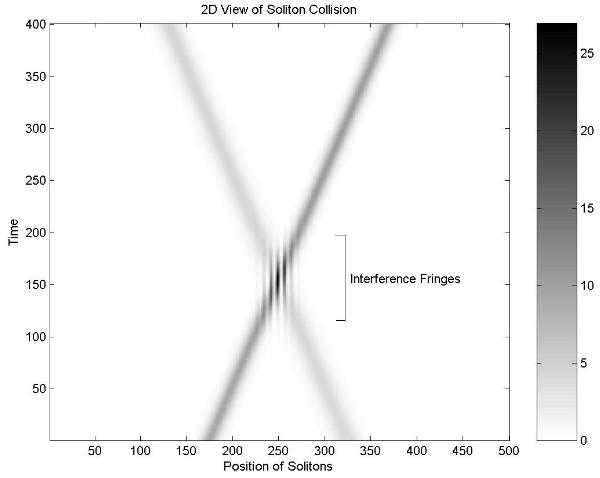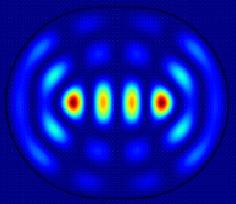V63.0394 Mathematical Wave Dynamics: SPRING 2004
Download: Course flyer, and
Syllabus.
Notice that our assigned room is now 1314 Warren Weaver Hall.
Waves and wave propagation are ubiquitous in nature
and lead to many puzzling questions. For instance, what produces
mirages in the desert? Why is it that a storm over the ocean sets off
a steady swell of small-amplitude waves, but an earthquake at the sea
floor can release an enormous flood wave? Can you hear the shape of a
drum? In response to these questions, a great deal of mathematics has
been developed to understand and predict the dynamics of light or
sound waves, the propagation of quantum (matter) waves, the vibration
patterns of elastic bodies, or the peculiar nature of water waves.
This course will give a guided tour of mathematical wave theory
together with physical applications, including normal mode theory, the
linear wave equation, superposition, interference and diffraction,
short-wavelength asymptotics and ray theory, dispersion, and nonlinear
waves and solitons. By the last few weeks of the course, each student
will have chosen a topic for more intensive study, and will work
towards a final oral presentation and written report. Typically this
will involve numerical investigation on a computer (in which case
programming experience is helpful), but a theoretical topic is also
possible.
This new course is part of the
Courant's VIGRE program,
and uses the `undergraduate mathematics laboratory' concept of bringing advanced
undergraduates together with postdocs and professors to work on current
pure or applied research topics, usually with computer experiments.

Lecture theory summary notes, weekly schedule:
- Simple harmonic motion and normal modes
and applet which
demonstrates this (slow the simulation speed way down and go to 2 masses).
- Variational method, continuous wave equation,
Fourier modes, and
applet for playing with
the wave equation (string under tension).
- Traveling solutions, reflection, energy,
plane waves, material interface
- WKB, 2D wave equation and plane waves,
2D refraction,
Matlab code for today's WKB plot.
(Kac drum problem links are below).
- Dispersion and ray method, Hamilton's equations,
applets illustrating dispersion (Schrodinger equation):
1d quantum mechanics and another.
- Nonlinear waves, traffic flow, shocks, solitons,
Burger's applet
and links on shocks and this amazing supersonic flyby,
and
solitons.
- Presentation of available student projects.
- Finite Difference methods for the time-dependent Schrodinger equation,
see R. LeVeque notes Ch. 1, 2.4, 6.2, Numerical Recipes Ch. 19.0, 19.4
(both linked below).
- Up-winding FD schemes and finite volume techniques for 1-way wave equation
(advection & traffic flow). matlab code for
O(dx) Godunov method.
- Radiating systems and the Greens function. In-class project work.
- April 6: Preliminary student presentations
(10 minutes each).
- Assessing convergence of a numerical scheme. In-class project work.
- More in-class project work.
- April 27th: Final Presentations (20 minutes each).
Final written reports due 2pm May 4th!
For ideas on typesetting your report,
and giving a scientific talk, see Other resources below.
Problem set related:
- Matlab code solution for problem set #1.
- Problem Set #2, due Feb 17, 2004.
Matlab code to generate solutions.
RESOURCES
Wave theory resources and demonstrations:
Numerical resources:
MATLAB resources:
Other resources:
PROJECTS
Initial topic ideas
- Sobolev's problem of dispersive
waves in a rotating tank.
- Traffic flow and shock waves.
- Bose-Einstein Condensate, numerical simulation of non-linear Schrodinger
Equation.
-
High-n wavepacket in Coulomb potential (Rydberg states of hydrogen).
- Resonances of elastic membranes (drums) of various shapes,
quantum chaos.
- Kac's problem: can you hear the shape of a drum (isospectral drums)?
Introduction
and paper (in gzipped PostScript - ask if you can't display) on this.
- Wave scattering from obstacles in 1D or 2D.
- Solitons in fiber-optic communication (1D).
- Time-reversed acoustics.
- Arterial pulse propagation in the human vascular system.
- Resonant modes of mechanical or musical systems.
Mid-semester project choice: download list (as of week 7).
- Jon Bober: Eigenvalue statistics for some quantum billiard systems. PDF (1.2MB) / .ps.gz (1.6MB)
- Yael Elmatad: Comparison of Finite Differences and WKB Method for Approximating Tunneling Times of the One Dimensional Schrodinger Equation. PDF (250kB)
- All MATLAB code is available here.
- Pete Johanson: Traffic models using continua and cellular automata.
.ps (460kB)
- Sameep Sangankar: Simulation of an atomic sample traveling around an oval waveguide.
.doc (44kB)
- Gabriel Shaykin: Effect of a vortex on a wave-packet.
(.doc 200kB, and
figures)
- Ed Suh: One-dimensional model of sea ice movement.
PDF (4.3MB).
- David Valdman: Soliton solutions of the nonlinear Schrodinger equation with application to Bose-Einstein Condensation.
.doc (850kB)






